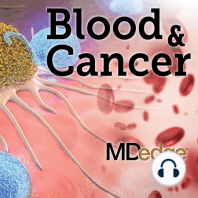22 min listen

Can aerosolized chemotherapy better treat peritoneal carcinomatosis in patients with gynecologic or gastrointestinal cancers?
FromBlood & Cancer
Can aerosolized chemotherapy better treat peritoneal carcinomatosis in patients with gynecologic or gastrointestinal cancers?
FromBlood & Cancer
ratings:
Length:
22 minutes
Released:
Dec 3, 2020
Format:
Podcast episode
Description
Researchers are conducting the first U.S. trial of pressurized intraperitoneal aerosolized chemotherapy (PIPAC) for the treatment of peritoneal carcinomatosis in patients with gynecologic or gastrointestinal cancers. Coprincipal investigator Thanh H. Dellinger, MD, of City of Hope in Duarte, Calif., describes this trial and the PIPAC procedure to host David H. Henry, MD, in this episode. To start, the pair discuss a patient who might be eligible for PIPAC – one with stage 3 ovarian cancer. General approach to stage 3 ovarian cancer Therapy typically includes a combination of surgery and chemotherapy. The order in which chemotherapy is given, either pre- or postoperatively, depends on performance status and whether patients have extra-abdominal disease or parenchymal liver disease. Operative approaches, including debulking surgery, are pursued if believed to be optimal, meaning all gross residual disease can be resected. If all residual disease cannot be resected, patients are offered neoadjuvant chemotherapy, typically for three to four cycles before an interval debulking surgery, followed by postoperative adjuvant chemotherapy. Intraperitoneal chemotherapy Intraperitoneal (IP) chemotherapy is used to treat peritoneal surface malignancies. The peritoneum is a separate organ that is difficult to treat adequately with intravenous chemotherapy alone. Giving IP chemotherapy in combination with intravenous chemotherapy may be more effective than intravenous chemotherapy alone (N Engl J Med. 2006; 354:34-43; https://bit.ly/3g3lngx). However, there are many challenges in delivering IP chemotherapy, including increased side effects of abdominal pain and IP catheter failure. Recent clinical trials have shown that, with the addition of bevacizumab, the survival benefit with IP chemotherapy may not be as significant as prior trials suggested (J Clin Oncol. 2019 Jun 1;37[16]:1380-90; https://bit.ly/2VAmRVW). In general, IP chemotherapy has not been embraced by the medical oncology community as much other types of chemotherapies, Dr. Dellinger said. What is PIPAC? PIPAC is a novel therapy discovered by a German surgical oncologist, Marc A. Reymond, MD, from University of Tuebingen (Germany). PIPAC delivers chemotherapy at a reduced dose directly into the intraperitoneal cavity but in a pressurized and aerosolized form. PIPAC is done at the time of the diagnostic laparoscopy and requires a nebulizer for aerosolization of the chemotherapy as well as a high-pressure injector. This approach allows for the chemotherapy to be pushed deeper into tissues, compared with hyperthermic intraoperative peritoneal chemotherapy (HIPEC). With HIPAC, tissue penetration is typically 1 mm or less. With PIPAC, there is deeper penetration and better distribution of chemotherapy throughout the entire intraperitoneal cavity. With PIPAC, chemotherapeutic agents are given at a lower dose than is typically administered with IP or intravenous chemotherapy, which helps in reducing the toxicity. PIPAC is given every 6 weeks for three cycles, requiring three laparoscopic procedures. These laparoscopic procedures allow for the opportunity to obtain peritoneal tumor biopsies before and after to investigate the natural course of these tumors and their microenvironment. Toxicity of PIPAC PIPAC has been done in more than 800 patients with gastrointestinal and gynecologic cancers in Europe and Asia. Severe adverse events have been minimal, with about 12%-15% grade 3/4 SAEs and very rare grade 5 SAEs. The most common side effect is typically abdominal pain, attributed to the IP administration in conjunction with the laparoscopic surgery. Renal toxicity is a concern with intravenous cisplatin use, but this has not yet been seen with PIPAC. With PIPAC, cisplatin is given at 10.1 mg/m2 and doxorubicin is given at 2.1 mg/m2, doses that are much lower than the typical doses for these drugs. PIPAC in clinical trials PIPAC clinical trials have moved into phase 2 in Europe f
Released:
Dec 3, 2020
Format:
Podcast episode
Titles in the series (100)
Treatment tips in CLL: The million-dollar question in the treatment of chronic lymphocytic leukemia (CLL) is what to do after a patient relapses following treatment with venetoclax. , and , both of Memorial Sloan Kettering in New York, join podcast host , of Pennsylvania... by Blood & Cancer